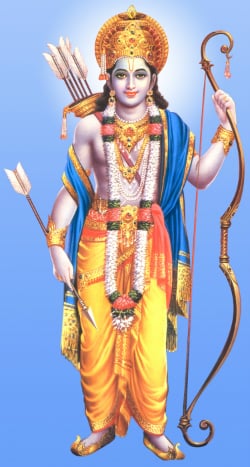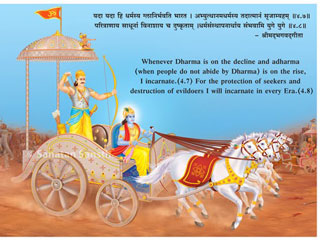 1. Vijayadashami
1. Vijayadashami
One derivation of the word Dussehra is from dashhara. ‘Dash’ means ten and ‘hara’ means defeated. Nine days before Dussehra, in the nine days of Navaratri, all the ten directions are saturated with the female Deity’s Divine Energy (Devi’s Shakti). ‘Shakti’ has control over Creation in all the ten directions, attendants, etc. This is why, this day is known as Dussehra, Dashara, Dasera, Vijayadashami, etc. This is one amongst the three and a half auspicious moments of the year. This comes on the tenth day of the bright fortnight of Ashwin. The immersion of the Navaratri (meaning, the Female Deity) is done on the ninth or the tenth day. Four rituals – crossing the territory (Known as Simollanghan), worship of the Shami tree (Known as Shamipujan), worship of the Deity Aparajita (Known as Aparajitapujan) and worship of instruments (Known as Shastrapuja) should be performed on this day.
2. History
1. Shriram’s ancestor, King Raghu of Ayodhya, performed the Vishwajit Yajna. He donated all his wealth and retired to a hut in the forest. Then, Sage Kautsa appeared before him and asked for an offering of fourteen crore gold coins. King Raghu prepared to attack Deity Kuber, the Deity of wealth, to obtain his requirement.
Deity Kuber showered gold coins on the Apta (Mountain Ebony) and Shami (Indian Mesquite) trees. King Raghu accepted only fourteen crore gold coins and his subjects took the rest. (Sage Kautsa accepted the gold coins he had asked for, and King Raghu distributed the rest amongst his subjects. This is true Hindu culture ! What a contrast to today’s politicians and people who crave for wealth and worldly pleasures ! – Compilers)
2. Shriram set out on this very day to defeat Ravan. Shriram killed Ravan on this day and was victorious. To mark this historic event, this day came to be known as Vijayadashami.
3. On the completion of their exile period, the Pandavas worshipped Shakti (Divine Energy), took back their weapons they had placed in the Shami tree, and subsequently defeated the Kaurav army (which had been stealing the cows of King Virat). This also occured on the same eventful day.
4. In Maharashtra, there is a custom of presenting leaves of the Apta tree, symbolising gold, to family members and friends on the Dussehra day. This custom too has historical significance. During any military expedition, the brave Marathas would invade and plunder the enemy’s territory and return home with the booty in the form of ornaments and gold coins. These victorious, brave soldiers would be welcomed home at the doorstep by their wives or sisters, who performed their Arati (Waving of lit lamps). They would then offer one of the ornaments from the booty to their wife or sister in the platter of the Arati. After entering the house, the booty would be placed before the Deities in the temple in the house. Then obeisance would be paid to the Deities and elders to seek their blessings.
These customs are observed today in the form of distributing Apta leaves.
3. Shastra-puja (Worship of weapons and instruments)
On this day Kings, their soldiers and feudal lords clean their weapons, arrange them in rows and worship them. Farmers and artisans too worship their respective implements or instruments. Some also perform this ritual on the day of Navami during Navaratri. The pen and books are like weapons for students; therefore, they worship them. The objective in this worship is to see the form of God in the respective things, meaning, trying to establish oneness with God.
4. Vijayadashami – A festival of the peasants too
Actually, this festival was celebrated even in the ancient times as a festival of the peasants. A peasant would celebrate it after bringing home his first monsoon harvest. During Navaratri, on the day of the installation of the pot, 9 types of food grains are germinated in the altar. On Dussehra, the sprouted grains are pulled out and offered to the Deities. In several places, the main door of the house is decorated with sheaves of rice grains. This custom also depicts that it is a festival of the peasants. With time, this festival became religious in nature.
Importance of Holy & Religious festivals and Vowed religious observances for God-realisationA. Since Holy festivals, Religious festivals and Vowed religious observances have a spiritual and scientific foundation, celebrating them leads to generation of Chaitanya (Divine consciousness) and that helps even an ordinary man to progress towards God. B. From a seeker’s perspective, Karmakanda may be an inferior form of spiritual practice, yet it is important to gradually divert people who are not performing any spiritual practice, towards Spirituality. From the perspective of Karmakanda, Holy festivals, Religious festivals and Vowed religious observances are so important that at least one or the other happens to be on 75% of the tithis (Dates according to the Hindu Lunar Almanac) in a year. C. We should always exercise restraint in our life; but in practice it is difficult. Hence, at least during Holy festivals, Religious festivals and Vowed religious observances it should be exercised, so that gradually we become accustomed to a life of restraint. Oppose practices that are harmful to Dharma and culture !Some practices have an important place in society; for example – firecrackers are lit during festivals such as Diwali and |

Since Hindu festivals have a spiritual & scientific foundation, celebrating them leads to generation of Chaitanya !

 Prohibition enforced in 17 sacred towns across Madhya Pradesh
Prohibition enforced in 17 sacred towns across Madhya Pradesh Radiant Thoughts of Sachchidananda Parabrahman (Dr) Jayant Athavale
Radiant Thoughts of Sachchidananda Parabrahman (Dr) Jayant Athavale Law banning Conversion of Religion is against Individual Freedom : Babbles Former Judge S Muralidhar
Law banning Conversion of Religion is against Individual Freedom : Babbles Former Judge S Muralidhar Editorial : Khalistan, Balochistan and Pakistan
Editorial : Khalistan, Balochistan and Pakistan After India becomes a ‘Hindu Rashtra’, Russia will embrace Hinduism and spread it globally : Nostradamus’ Prophecy
After India becomes a ‘Hindu Rashtra’, Russia will embrace Hinduism and spread it globally : Nostradamus’ Prophecy ‘Halt Public Spending on Aurangzeb’s Tomb, Prioritise Maharashtra’s Heritage’ : HJS
‘Halt Public Spending on Aurangzeb’s Tomb, Prioritise Maharashtra’s Heritage’ : HJS